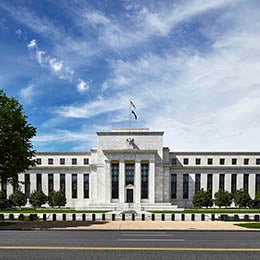
The Fed Minute video series
Here’s a quick recap and analysis of the latest Federal Open Market Committee meeting and what it may mean for liquidity investors.
One of the industry’s largest providers of cash management solutions globally.2
Invesco has managed cash and ultra short duration assets for over 40 years.1
A dedicated team of investment professionals with an average 21 years of experience.1
We have an established legacy of managing money markets and navigating the front end of the yield curve through numerous market environments, interest rate regimes, and credit events. We seek to leverage our team’s experience, knowledge and relationships to generate performance while preserving capital and maintaining liquidity.

Laurie Brignac, CIO of Invesco Global Liquidity, describes² how cash managers need to balance three objectives: protecting principal, maintaining liquidity, and generating competitive yields. Find out how Invesco can help meet your cash management needs.
All global liquidity managers need to balance three objectives: protecting principal, offering ample liquidity, and generating competitive yields.
But not all cash management providers are alike. Here are three reasons to partner with Invesco for your liquidity needs.
First, we have a seasoned team of cash management experts.
We’ve been managing cash for more than 40 years, spanning recessions, wars, a global pandemic, and multiple monetary tightening cycles.
Our rigorous process combines top-down macro positioning and bottom-up credit selection using deep sector expertise.
We do all this by leveraging Invesco’s global fixed income platform.
Second, we offer a range of cash management solutions for a diverse client base.
Whether your priority is preserving principle or generating yield, we have solutions to fit your needs, including money market funds and ultrashort and short duration funds.
For individual investors and their financial professional, we offer our solutions through mutual funds, ETFs, and separately managed accounts.
And for institutional clients, we can construct custom portfolios to help meet specific liquidity and income needs.
Third, we help financial professionals deliver an institutional approach to cash management for their clients.
Many sophisticated institutional investors use a strategy called cash segmentation, which involves separating their cash holdings into “buckets” by investment horizon and liquidity needs.
Cash segmentation can help investors of all sizes generate more income while still seeking to preserve capital.
We invite you to learn more about our cash management solutions.
Let’s start the conversation today!
Not a Deposit | Not FDIC Insured | Not Guaranteed by the Bank | May Lose Value | Not Insured by any Federal Government Agency
Fixed-income investments are subject to credit risk of the issuer and the effects of changing interest rates. Interest rate risk refers to the risk that bond prices generally fall as interest rates rise and vice versa. An issuer may be unable to meet interest and/or principal payments, thereby causing its instruments to decrease in value and lowering the issuer’s credit rating.
This does not constitute a recommendation of any investment strategy for a particular investor. There is no guarantee these strategies will be able to meet their objectives. Past performance cannot guarantee future comparable results.
Institutional Separate Accounts and Separately Managed Accounts are offered by affiliated investment advisers, which provide investment advisory services and do not sell securities. These firms, like Invesco Distributors, Inc., are indirect, wholly owned subsidiaries of Invesco Ltd.
Before investing, investors should carefully read the prospectus/summary prospectus and carefully consider the investment objectives, risks, charges and expenses. For this and more complete information about the Fund visit invesco.com for the prospectus/summary prospectus.
Invesco Distributors, Inc. 03/23 NA2731442 FIGLLIQ-VID-1-E
| Ticker | Fund name | Vehicle | Type | Download |
|---|---|---|---|---|
| AGPXX | Invesco Government & Agency Portfolio | Mutual Fund | Government & Agency | Fact Sheet |
| AIYXX | Invesco Government Money Market Fund | Mutual Fund | Government & Agency | Fact Sheet |
| IUGXX | Invesco Premier U.S. Government Money Portfolio | Mutual Fund | Government & Agency | Fact Sheet |
| OMBXX | Invesco U.S. Government Money Portfolio | Mutual Fund | Government & Agency | N/A |
| TRPXX | Invesco Treasury Portfolio | Mutual Fund | Treasury & Repo | Fact Sheet |
| TSPXX | Invesco Treasury Obligations Porfolio | Mutual Fund | Treasury Only | Fact Sheet |
| IPPXX | Invesco Premier Portfolio | Mutual Fund | Retail Prime | Fact Sheet |
| Ticker | Fund name | Vehicle | Duration | Download |
|---|---|---|---|---|
| ICIYX(Y) | Invesco Conservative Income Fund | Mutual Fund | Ultrashort | Fact sheet |
| ICIVX (A) | Invesco Conservative Income Fund | Mutual Fund | Ultrashort | Fact sheet |
| GSY | Invesco Ultra Short Duration ETF | ETF | Ultrashort | Fact sheet |
| TBLL | Invesco Short Term Treasury ETF | ETF | Ultrashort | Fact sheet |
| VRIG | Invesco Variable Rate Investment Grade ETF | ETF | Ultrashort | Fact sheet |
| STBYX (Y) | Invesco Short Term Bond Fund | Mutual Fund | Short Term | Fact sheet |
| STBAX (A) | Invesco Short Term Bond Fund | Mutual Fund | Short Term | Fact sheet |
| ORSYX (Y) | Invesco Short Term Municipal Fund | Mutual Fund | Short Term | Fact sheet |
| ORSTX (A) | Invesco Short Term Municipal Fund | Mutual Fund | Short Term | Fact sheet |
| GTOS | Invesco Short Duration Total Return Bond ETF | ETF | Short Term | Fact sheet |
A money market fund is a type of mutual fund that invests in short-term, high-quality debt instruments like government securities, certificates of deposit, and commercial paper. It’s designed to offer stability, liquidity, and modest income.
A government money market fund is a type of mutual fund that invests primarily in short-term debt securities issued by the U.S. government, such as Treasury bills, notes, and bonds, or in repurchase agreements (repos) backed by these securities.
Prime money market funds are a type of mutual fund that invests primarily in corporate debt and other taxable short-term securities, such as commercial paper, certificates of deposit, and asset-backed commercial paper.
Ultrashort and short-term bond funds are investments that hold debt securities with short maturities, typically less than one year for ultrashort funds and one to three years for short-term funds. They are considered lower-risk, low-return investments, designed to provide capital preservation and liquidity with minimal exposure to interest-rate fluctuations.
While not guaranteed, money market funds are considered low-risk because they invest in high quality, short-term securities, and adhere to specific regulations prescribed by the SEC. Money market funds aim to preserve capital and provide liquidity.
Money market funds are ideal for investors seeking a place to hold cash, manage liquidity, or park funds temporarily while waiting for other investment opportunities.

The Fed Minute video series
Here’s a quick recap and analysis of the latest Federal Open Market Committee meeting and what it may mean for liquidity investors.

Invesco has many fixed income strategies to help you meet your goals, including taxable bonds, tax-free municipals, mutual funds, ETFs, and SMAs.

Discover the potential benefits of investing in Invesco’s fixed income ETFs, such as income generation, portfolio diversification, and risk mitigation.

Cash segmentation can help you allocate your investments to capture income potential and maintain portfolio stability.
NA 4849882
Class Y shares are closed to most investors. Please see the prospectus for more details.
Invesco Government & Agency Portfolio, Invesco Treasury Obligations Portfolio, Invesco Premier U.S. Government Money Portfolio, Invesco Treasury Portfolio, Invesco Government Money Market Fund, Invesco U.S. Government Money Portfolio: You could lose money by investing in the Fund. Although the Fund seeks to preserve your investment at $1.00 per share, it cannot guarantee it will do so. An investment in the Fund is not a bank account and is not insured or guaranteed by the Federal Deposit Insurance Corporation or any other government agency. The Fund’s sponsor is not required to reimburse the Fund for losses, and you should not expect that the sponsor will provide financial support to the Fund at any time, including during periods of market stress.
Invesco Premier Portfolio: You could lose money by investing in the Fund. Although the Fund seeks to preserve your investment at $1.00 per share, it cannot guarantee it will do so. An investment in the Fund is not a bank account and is not insured or guaranteed by the Federal Deposit Insurance Corporation or any other government agency. The Fund may impose a fee upon the sale of your shares. The Fund’s sponsor is not required to reimburse the Fund for losses, and you should not expect that the sponsor will provide financial support to the Fund at any time, including during periods of market stress.
Fixed-income investments are subject to credit risk of the issuer and the effects of changing interest rates. Interest rate risk refers to the risk that bond prices generally fall as interest rates rise and vice versa. An issuer may be unable to meet interest and/or principal payments, thereby causing its instruments to decrease in value and lowering the issuer’s credit rating.
The yield curve plots interest rates, at a set point in time, of bonds having equal credit quality but differing maturity dates to project future interest rate changes and economic activity.
Diversification does not guarantee a profit or eliminate the risk of loss.
There are risks involved with investing in ETFs, including possible loss of money. Index-based ETFs are not actively managed. Actively managed ETFs do not necessarily seek to replicate the performance of a specified index. Both index-based and actively managed ETFs are subject to risks similar to stocks, including those related to short selling and margin maintenance. Ordinary brokerage commissions apply. The Fund's return may not match the return of the Index. The funds are subject to certain other risks. Please see the current prospectus for more information regarding the fund.
This link takes you to a site not affiliated with Invesco. The site is for informational purposes only. Invesco does not guarantee nor take any responsibility for any of the content.